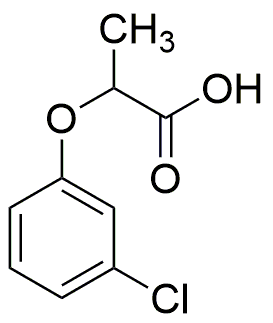2-(3-Chlorophenoxy)propionic acid is widely utilized in research focused on
- Agriculture: This compound serves as a herbicide, effectively controlling a variety of broadleaf weeds in crops, which helps farmers increase yield and reduce competition for nutrients.
- Pharmaceuticals: It is used in the synthesis of various pharmaceutical agents, contributing to the development of medications that target specific biological pathways.
- Research and Development: In laboratories, it acts as a valuable reagent for studying biochemical processes, allowing researchers to explore its effects on plant growth and metabolism.
- Environmental Science: The compound is utilized in studies assessing the impact of herbicides on ecosystems, helping scientists understand and mitigate environmental risks associated with agricultural practices.
- Chemical Manufacturing: It plays a role in the production of specialty chemicals, where its unique properties can enhance the performance of various formulations.
Información general
Propiedades
Seguridad y normativas
Aplicaciones
2-(3-Chlorophenoxy)propionic acid is widely utilized in research focused on
- Agriculture: This compound serves as a herbicide, effectively controlling a variety of broadleaf weeds in crops, which helps farmers increase yield and reduce competition for nutrients.
- Pharmaceuticals: It is used in the synthesis of various pharmaceutical agents, contributing to the development of medications that target specific biological pathways.
- Research and Development: In laboratories, it acts as a valuable reagent for studying biochemical processes, allowing researchers to explore its effects on plant growth and metabolism.
- Environmental Science: The compound is utilized in studies assessing the impact of herbicides on ecosystems, helping scientists understand and mitigate environmental risks associated with agricultural practices.
- Chemical Manufacturing: It plays a role in the production of specialty chemicals, where its unique properties can enhance the performance of various formulations.
Documentos
Hojas de datos de seguridad (HDS)
La SDS proporciona información de seguridad completa sobre la manipulación, el almacenamiento y la eliminación del producto.
Especificación del producto (PS)
La PS proporciona un desglose completo de las propiedades del producto, incluida la composición química, el estado físico, la pureza y los requisitos de almacenamiento. También detalla los rangos de calidad aceptables y las aplicaciones previstas del producto.
Certificados de análisis (COA)
Busque certificados de análisis (COA) ingresando el número de lote del producto. Los números de lote y de partida se pueden encontrar en la etiqueta de un producto después de las palabras "Lote" o "Lote".
Número de catálogo
Número de lote/lote
Certificados de origen (COO)
Este certificado de origen confirma el país en el que se fabricó el producto y también detalla los materiales y componentes utilizados en él y si se deriva de fuentes naturales, sintéticas u otras fuentes específicas. Este certificado puede ser necesario para cumplir con las normativas aduaneras, comerciales y regulatorias.
Número de catálogo
Número de lote/lote
Hojas de datos de seguridad (HDS)
La SDS proporciona información de seguridad completa sobre la manipulación, el almacenamiento y la eliminación del producto.
DownloadEspecificación del producto (PS)
La PS proporciona un desglose completo de las propiedades del producto, incluida la composición química, el estado físico, la pureza y los requisitos de almacenamiento. También detalla los rangos de calidad aceptables y las aplicaciones previstas del producto.
DownloadCertificados de análisis (COA)
Busque certificados de análisis (COA) ingresando el número de lote del producto. Los números de lote y de partida se pueden encontrar en la etiqueta de un producto después de las palabras "Lote" o "Lote".
Número de catálogo
Número de lote/lote
Certificados de origen (COO)
Este certificado de origen confirma el país en el que se fabricó el producto y también detalla los materiales y componentes utilizados en él y si se deriva de fuentes naturales, sintéticas u otras fuentes específicas. Este certificado puede ser necesario para cumplir con las normativas aduaneras, comerciales y regulatorias.


